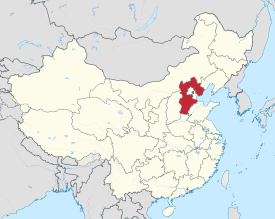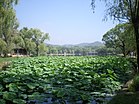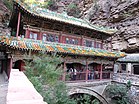
Back Hebei ACE Hebei Afrikaans خبي Arabic Hebei AST Hebei Azerbaijani Хэбэй Byelorussian Хъбей Bulgarian হপেই Bengali/Bangla ཧའོ་པེ་ཞིང་ཆེན། Tibetan Hebei Breton
This article needs additional citations for verification. (July 2014) |
Hebei
河北 | |
|---|---|
| Province of Hebei | |
| Name transcription(s) | |
| • Chinese | 河北省 (Héběi shěng) |
| • Abbreviation |
|
Clockwise: Great Wall at Jinshanling, Chengde Mountain Resort, Puning Temple, Fuqing Temple at Cangyan Mountain, Beidaihe in Qinhuangdao | |
 Map showing the location of Hebei Province | |
| Coordinates: 39°18′N 116°42′E / 39.3°N 116.7°E | |
| Country | China |
| Named for | Yellow River |
| Capital and largest city | Shijiazhuang |
| Divisions | 11 prefectures, 121 Counties, 2207 Townships |
| Government | |
| • Type | Province |
| • Body | Hebei Provincial People's Congress |
| • CCP Secretary | Ni Yuefeng |
| • Congress chairman | Ni Yuefeng |
| • Governor | Wang Zhengpu |
| • CPPCC chairman | Lian Yimin |
| Area | |
| • Total | 188,800 km2 (72,900 sq mi) |
| • Rank | 12th |
| Highest elevation | 2,882 m (9,455 ft) |
| Population (2020)[2] | |
| • Total | 74,610,235 |
| • Rank | 6th |
| • Density | 400/km2 (1,000/sq mi) |
| • Rank | 11th |
| Demographics | |
| • Ethnic composition | |
| • Languages and dialects | Jilu Mandarin, Beijing Mandarin, Jin |
| GDP[3] | |
| • Total | CN¥4.039 trillion US$635 billion |
| • Per capita | CN¥54,172 US$8,397 |
| ISO 3166 code | CN-HE |
| HDI (2019) | high · 20th |
| Website | hebei.gov.cn |
| Hebei | |||||||||||||||||||||||||||||||||||||||||
|---|---|---|---|---|---|---|---|---|---|---|---|---|---|---|---|---|---|---|---|---|---|---|---|---|---|---|---|---|---|---|---|---|---|---|---|---|---|---|---|---|---|
"Hebei" in Chinese characters | |||||||||||||||||||||||||||||||||||||||||
| Chinese | 河北 | ||||||||||||||||||||||||||||||||||||||||
| Postal | Hopeh | ||||||||||||||||||||||||||||||||||||||||
| Literal meaning | North of the Yellow River | ||||||||||||||||||||||||||||||||||||||||
| |||||||||||||||||||||||||||||||||||||||||
| Abbreviation | |||||||||||||||||||||||||||||||||||||||||
| Chinese | 冀 | ||||||||||||||||||||||||||||||||||||||||
| |||||||||||||||||||||||||||||||||||||||||
| Zhili Province | |||||||||||||||||||||||||||||||||||||||||
| Traditional Chinese | 直隸省 | ||||||||||||||||||||||||||||||||||||||||
| Simplified Chinese | 直隶省 | ||||||||||||||||||||||||||||||||||||||||
| Literal meaning | Directly ruled | ||||||||||||||||||||||||||||||||||||||||
| |||||||||||||||||||||||||||||||||||||||||
Hebei[a] is a province in North China. Hebei is China's sixth most-populous province, with over 75 million people. Shijiazhuang is the capital city. The province is 96% Han Chinese, 3% Manchu, 0.8% Hui, and 0.3% Mongol. Varieties of Chinese spoken include Jilu Mandarin, the Beijing dialect of Mandarin, and Jin Chinese.
Hebei borders the provinces of Shanxi to the west, Henan to the south, Shandong to the southeast, Liaoning to the northeast, and the Inner Mongolia Autonomous Region to the north. Hebei province additionally borders the direct-administered municipalities of Beijing and Tianjin, whose territory it entirely surrounds on land. Its economy is based on agriculture and manufacturing. The province is China's premier steel producer, although the steel industry creates serious air pollution.[8][9][10]
Five UNESCO World Heritage Sites can be found in the province: the Great Wall of China, Chengde Mountain Resort, Grand Canal, Eastern Qing tombs, and Western Qing tombs. It is also home to five National Famous Historical and Cultural Cities: Handan, Baoding, Chengde, Zhengding and Shanhaiguan.
During the Spring and Autumn and Warring States periods (771–226 BC), the region was ruled by the states of Yan and Zhao. During the Yuan dynasty (1271–1368), the region was called Zhongshu. It was called North Zhili during the Ming dynasty (1368–1644), and simply Zhili during the Qing dynasty (1644–1912). The modern province of Hebei was created in 1928.
- ^ Liu, Yanlin (2015). 太行山把最高的山脊留在了河北. Chinese National Geography (in Simplified Chinese) (2). Retrieved 20 May 2018.
小五台山是太行山主脉上的最高峰,同时也是河北省的最高峰
- ^ "Communiqué of the Seventh National Population Census (No. 3)". National Bureau of Statistics of China. 11 May 2021. Retrieved 11 May 2021.
- ^ GDP-2020 is a preliminary data "Regional – Quarterly by Province" (Press release). China NBS. March 1, 2021. Retrieved March 23, 2021.
- ^ "Sub-national HDI – Subnational HDI – Global Data Lab". globaldatalab.org. Retrieved 2020-04-17.
- ^ Longman, J.C. (2008). Longman Pronunciation Dictionary (3rd ed.). Pearson Education ESL. ISBN 978-1405881173.
- ^ "Hebei". Lexico UK English Dictionary. Oxford University Press. Archived from the original on May 18, 2021.
- ^ "Hebei". Merriam-Webster.com Dictionary.
- ^ "河北概况". 河北省人民政府. Archived from the original on 2020-08-13. Retrieved 2020-01-23.
- ^ "河北省工业经济概况". 河北省工业和信息化厅. Archived from the original on 2020-01-21. Retrieved 2020-01-23.
- ^ "河北钢铁工业概况". 中国铁合金网. Archived from the original on 2020-02-18. Retrieved 2020-01-23.
Cite error: There are <ref group=lower-alpha> tags or {{efn}} templates on this page, but the references will not show without a {{reflist|group=lower-alpha}} template or {{notelist}} template (see the help page).
© MMXXIII Rich X Search. We shall prevail. All rights reserved. Rich X Search




